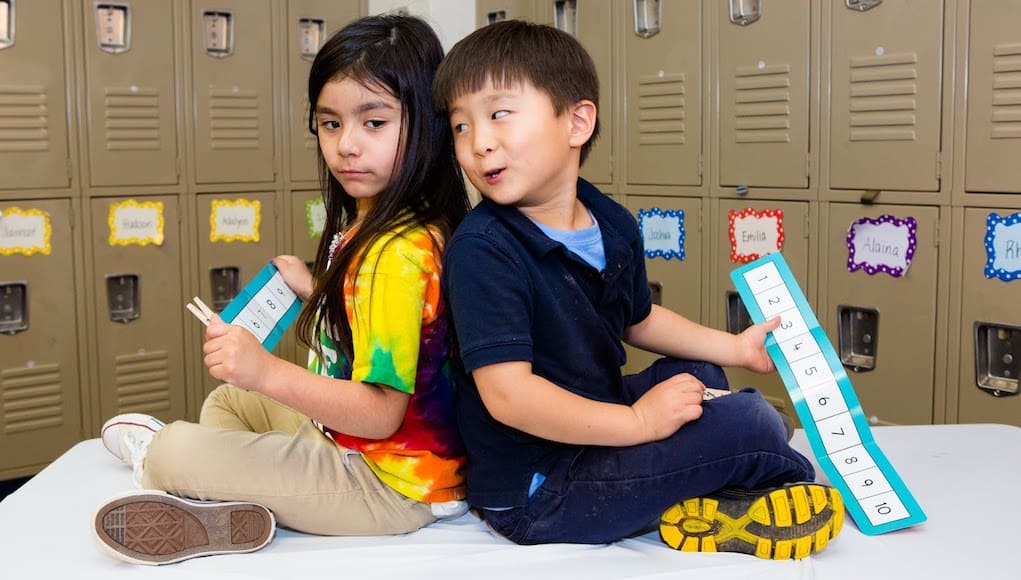Six Strategies to Help Academic Language Learners (ALL) Succeed in Early Math

By Jessica Bobo
With the average percentage of U.S. students who are English language learners (ELL) ranging from 16.7% in kindergarten to 14.9% in grade three, a significant number of educators in the early grades are teaching ELLs in their classrooms.
Before we embark on the six strategies to help all children succeed, I think it’s important to note there are many phases when learning the English language. Let’s discuss the main three.
At the beginning phase, children have little to no English language ability. They might be able to understand some spoken English, but their capacity to converse in English is very limited. Typically, children don’t use much academic language in this beginning phase, if any. They are just learning social English, such as “hi,” “play,” and so on.
The next phase is intermediate English. This is where children have become more comfortable with the social language, and now they’re starting to branch out into the world of academic language. At this point, they might also be creating full sentences. This is the phase that is going to last the longest for most children, as they become fully immersed in exploring the English language.
In the advanced phase, children can make beautiful sentences. There are still many words they are learning, but they are fluent enough to have conversations with their peers, as well as use academic discourse in class. Their English is no longer broken, and they can truly comprehend what they are learning academically.
But if you think about it, all young children are Academic Language Learners (ALL) because they are learning academic English for the first time. In this sense, the language of mathematics is brand new to all of them. While these strategies include best practices for helping ELL succeed in particular, they are actually beneficial for ALL.
I taught in an elementary ELL classroom for a decade. Whenever I had children coming in who were English language learners, the first thing I would do is send home a book I had created about myself. It had pictures of my life and my family, which would help them see who I was as an educator. This was my way of extending a hand of trust to them so they can start feeling comfortable in my community of learners.
I would use Google translate to write them a letter in their native language asking them to create a book for me to explore more about them and their family. This was a great icebreaker, as well as a way to build a bridge of trust with the child. In my classroom we were a family, we did not judge, and we welcomed everyone with open arms. In doing this, I was building a rapport and establishing that my classroom was a safe space and it always helped start them on their journey for learning.
Once I had established our relationship, the child could then start learning from the six strategies I would use to ensure that all children learned early math skills in my classroom effectively:
Nonverbal Cues
One thing I would do is model the use of thumbs up, thumbs down, and thumbs sideways gestures, so that even students at the very beginning phases of learning English had a way to communicate with me.
Whenever I saw students do something correctly or follow directions, I would give them a warm smile, a thumbs up and say, “That’s great! Sugar Sprinkles to you! Thank you for understanding.” When something wasn’t right or they didn’t understand, I would give them a thumbs sideways and say, “Let’s try this again. I believe in you.” Seeing me use these gestures, alongside my language, is a very important stepping stone for them to eventually feel confident in using them on their own.
After modeling the use of these hand gestures for about a week, I would invite the children to use the gestures for themselves. This gave them a way to communicate with me nonverbally while they were beginning to learn English—because they could use hand gestures to tell me if they didn’t understand something I had said without broadcasting this to the rest of the class.
Sentence Stems
Another critical strategy I used was giving the children sentence stems. Suppose I was teaching about 3D figures. As students held a cube in their hands, I would give them a sentence stem like, “The box feels…” And I would prompt them to finish the sentence. A child might say, “The box feels smooth.” I would give a thumbs up and say, “That’s right. Smooth is another way of saying it has a flat surface. The box feels smooth because it has a flat surface.” I would invite the child to repeat the full sentence after me in a choral response. Children need to both hear the language, as well as speak the language. Speaking and listening activate two different parts of the brain, and we need to develop both to help students learn effectively.

Partner talk
Peer relationships are crucial for ELLs to learn both social and academic language. When a bridge of trust is built between two children, it paves the way for the ELL to take language risks that so often times leads to great gains. That is why I would pair children who were in the beginning or intermediate phases of English language development with the same partner every time. They had their social needs met, which in turn, meant they could learn freely without judgment.
Scaffolding language
As children are learning the academic language of math, there is a progression that teachers should use to help them learn more effectively. The first stage involves using the natural language of children, which links math to concepts they already know.
If I was talking about subtraction, I’d ask students, “If I have five grapes, and I eat one, how many grapes do I have left?” This naturally links to the experiences that both English-speaking children and ELL have had, because all children have experienced eating grapes.
The next stage is using materials language, where children are working out the subtraction concept using materials in connection to the language. This is where I might use words like “take away” to represent a grape being removed. Then, we would move to mathematical language, where we would finally say the word “subtract” and link it to the concept of subtraction. And eventually we would move on to symbolic language, where the children actually learn the symbols representing subtraction: 8 – 2 = 6.
Moving very deliberately through a progression of language gives children stepping stones to help them not only learn math concepts more effectively, but also link these concepts to the language we use to describe them in a very non-threatening way.

Visual models
Using visual models such as manipulatives and vocabulary cards with pictures, or math models such as ten-frames and numeral expanders, also helps children link math concepts with the language used to describe them. Some children must actually hold objects in their hand to truly grasp what’s being said. When talking about place value, for instance, allow the children to build the number using place value blocks and then relate the number to a numeral expander; that way, they understand and can picture in their mind that 3 hundreds, 1 ten, and 4 ones means 314.

Wait time
Finally, it’s very important to give children time to process what is being said before moving on. Whenever a new math word is introduced, children should be given a definition and an example, and then be allowed to sit there and wait. While this wait time might seem awkward, it gives children an opportunity to think about that word and what they might know about it, and lets the word marinate in their brain.
Then, children should have a conversation with their partner about the word. What are their experiences with that word? Where have they seen it before—or, is it brand new to them? What questions do they have about it?
Think about your own experience when you are listening to new information and trying to take notes. You’re probably at least a few sentences behind the whole time, trying to process what you’ve already heard as the speaker continues to talk. It’s the same for children when they are learning new words and concepts. Teachers have to be very intentional with this wait time so that when children hear a word, they internalize it and have a chance to talk about it.
Learning is a very social process, and we as an educational society must honor this. A language-rich approach allows students to understand math concepts much more deeply—and applying these strategies will ensure that ALL students learn in your early math classroom, regardless of their initial understanding of English.
For more, see:
- Infographic | Math Success for English Language Learners
- 20 Math and ELA Tools that Support English Language Learners
- The Scoop on Deeper Learning and Mathematics: English Language Learner Edition
Jessica Bobo is an early childhood math consultant and Author of ORIGO Stepping Stones Pre-K for ORIGO Education, which helps children to develop a conceptual understanding of key math concepts.
Stay in-the-know with all things EdTech and innovations in learning by signing up to receive the weekly Smart Update.



0 Comments
Leave a Comment
Your email address will not be published. All fields are required.